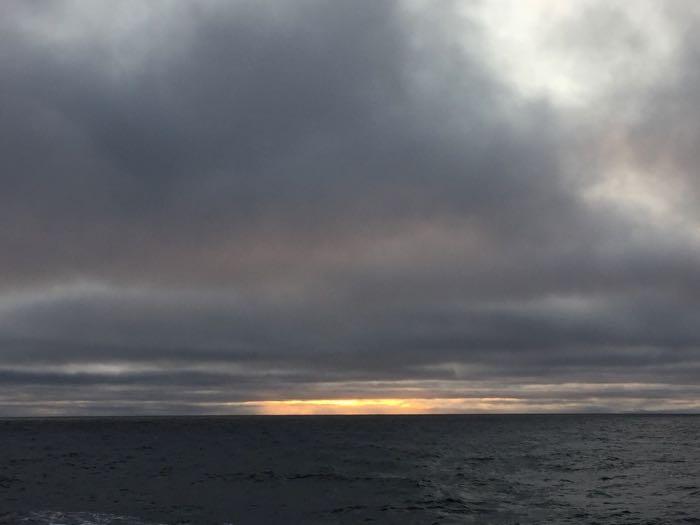Today is the equinox. Here on the icebreaker Federov, we traveled across multiple time zones in one day. That makes things more complicated. But if we had stayed in one spot, we would have experienced about 12 hours of daylight and an equal amount of darkness. Just like everywhere else on the planet!
 This screen in the dining area provided up-to-date information on our location. But the date was always wrong!
This screen in the dining area provided up-to-date information on our location. But the date was always wrong!
But today I was reminded that daylight doesn’t simply mean sun. We had lots of ever-changing weather, including lots of snow! There were also times when the sun streamed through patchy clouds. The weather and sea conditions created a beautiful landscape of light and dark throughout the day. It felt like a natural celebration of the splendor and variety of a term like daylight. We’ve had thick, blowing snow. We’ve had heavy low clouds and even fog that reaches right down to the water. Clouds have parted to reveal patches of blue sky or the pearly bright light of the sun through thinner cloud layers. In some spots on the horizon (where the sky meets the ocean) there is a line of shimmery silver. Sun must be reflecting off the water there. At other places, the horizon is dark. The clouds are low and heavy there, shading that area of water. I can even see blue-grey streaks of precipitation (rain, snow, hail, or sleet) beneath some of the clouds. Closer to the ship, swells and waves reflect and absorb light in different patches. It really is all beautiful!




 These photos demonstrate the beautiful diversity of daylight we experienced during the equinox, mediated by clouds and seascape. There were also times with blowing snow, but it was too wet to use my camera.
These photos demonstrate the beautiful diversity of daylight we experienced during the equinox, mediated by clouds and seascape. There were also times with blowing snow, but it was too wet to use my camera.
Now, a little more about the equinox...
Each year, the September Equinox occurs. It is when every place on earth receives about 12 hours of daylight and about 12 hours of darkness. Isn’t that remarkable? For this day (and also the March equinox) everywhere gets approximately equal amounts of lightness and darkness. Obviously, things can block this light, like clouds, or mountains, or even large buildings. But overall, every single spot you can find on the earth should get about 12 hours of daylight and about 12 hours of night next week, on September 23. This means that where I’ll be in the Arctic Ocean next week will get about 12 hours of daylight, my parents in Alaska will get about 12 hours of daylight, my partner in Washington will get about 12 hours of daylight, my grandma in Pennsylvania will get about 12 hours of daylight, my friends in Louisana will get about 12 hours of daylight. Even in the southern hemisphere -- my friends in Chile and Kenya and the Philippines and New Zealand will all get about 12 hours of daylight. Even people doing research in the Antarctic!
In the northern hemisphere, this is called the fall or “autumnal” equinox. But in the southern hemisphere, it is the spring or “vernal” equinox. Either way, the September equinox represents a shift between seasons for everywhere except the equator. These seasons shift a lot faster near the poles -- within a month, the polar night will reach latitude 80 degrees north. The sun will set there, and not rise again for over 120 days! But in the summer, they get over 120 days of straight daylight!
Whether you teach in a classroom, nature center, museum, outdoor classroom, at home, or an infinite number of other places, the September equinox marks a great opportunity to learn more about astronomy and earth’s seasons.
In case you need a refresher, here’s a nice overview of the basic science.
 Reflection
Reflection
Education Extensions
Equinox Activities
In this Google Doc, I recommend some videos and lessons that might be good in more formal settings and pair nicely with the art, kinesthetic, and observation activities. But if you work outside or at an informal learning center, you might decide just to focus on these first few options. Either way - I hope you can enjoy these activities!


Comments
Add new comment